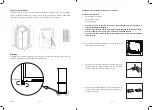
23
V.1.0
22
V.1.0
UNPACKAGING
•
Remove the packaging.
•
Check that the appliance has not been damaged during transport. Do not plug the
appliance into the mains if damaged! Contact your retailer instead.
•
Remove all the adhesive tape and packaging materials from the inside and outside of the
appliance. Remove any accessories (ice cube tray, egg rack, etc.) that may be supplied with
the appliance.
B
EFORE
INITIAL
USE
•
Clean the inside of the appliance and any accessories provided with warm water and a
little white vinegar. Do not use soap or detergents as the odour can linger. When you have
fi nished cleaning the appliance, dry it completely.
•
White spirit can be used to remove adhesive residue from the exterior.
Always unplug the appliance, remove the fuse or switch off the circuit breaker before
cleaning.
INSTALLATION
I
NSTALLATION
LOCATION
•
Stand the refrigerator-freezer on a fl at, even surface. As your appliance will be heavy when
fi lled with food, it must be stood on a strong, solid fl oor.
•
The appliance must be installed in a dry, well-ventilated room at ambient temperature. Be
sure to leave a space of at least 10cm around the appliance.
•
Do not expose the appliance to direct sunlight.
•
Do not expose the appliance to rain.
•
Do not install the appliance next to radiators, cookers or other heat sources.
•
The ambient temperature aff ects energy consumption and appliance effi ciency.
•
The mains outlet must remain accessible when the appliance is installed.
•
After installation, make sure that the appliance does not rest on its power supply cable.
•
Before plugging the appliance into the mains for the fi rst time, allow 2 hours for it
to settle if it has been transported in the upright position, or 24 hours if it has been
transported horizontally; this is to allow the refrigerant gas to fl ow back into the
compressor. Failure to do so could damage the compressor.
•
This refrigeration appliance is not intended to be used as a built-in appliance.
C
LIMATE
CLASS
The appliance must be installed in a location with an ambient temperature that is
compatible with the climate class for which it was designed (see table below).
The climate class is on the data plate on the outside of the appliance. The table below sets out
which ambient temperatures are compatible with which climatic classes:
Climate class
Ambient temperature
SN
from +10 to +32°C
N
from +16 to +32°C
ST
from +16 to +38°C
T
from +16 to +43°C
Your device is classifi ed as “N/ST”. Above or below the indicated temperatures, the
performance of your refrigerator-freezer may be aff ected and your food may perish.













































